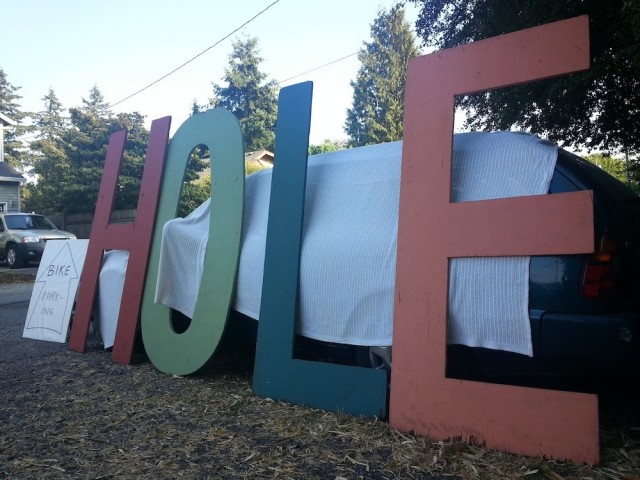The Mind Behind the Woodstock Mystery Hole and the Universal Church O’Fun
Barron Mind didn’t invent fun. He just wrote a pamphlet on how to have fun, how to make fun, how to be fun. He founded the Universal Church O’Fun (the Sabbath is Funday). In his backyard, he built a fun regenerator from a piece of waterslide, because his Woodstock neighborhood needed more fun. What does Barron do for fun?
“Everything I do is fun,” he says.
Like hosting a meteor-catching competition in his backyard once every August. This year’s competition was suspended, the way Barron tells it, because the Environmental Protection Agency panicked at asbestos levels in catchers’ mitts. To abolish the competition entirely, though, wouldn’t be fun. So this year, the meteor that landed closest to you was yours to keep. Barron sought out the owners of the weirdest and largest meteors, and declared them the winners.
That’s just the tail end of his annual meteor shower. The rest of the meteor shower looks like any August BBQ in Portland. Except Barron, who labels every door, ladder, and mirror in his backyard amusement park, labels vegan dishes “vegan” and meat dishes “meat.” He labels the coffee, “coffee w/ caffeine.” He labels his two outdoor gender-neutral restrooms, “stand to pee,” and “squat to pee.” He labels the mystery hole and the mystery pole, and the history mole of the mystery hole, a prop custom built for Barron by Hollywood art directors with some spare time.
All of the mysteries in Barron’s world come with labels and explanations. The crates of hole air guarantee they were bottled in the depths of the mystery hole. The dollar bill, available for 99 cents, claims it is a special purchase. The postcards, full-color shots of the pitch black hole innards, come in two varieties—horizontal black rectangle and vertical black rectangle. Some items gain value with a label: brass hooks become bronze question marks.
The people wear no labels. They wear black t-shirts with a spiral mystery hole icon and a question mark. Sometimes they banter with Barron, but not for long. Their host slips into conversation to drop a one-liner or clear up some whisper about his personality—“What subject do I specialize in substitute teaching? Substituting is a specialty”—then vanishes to reappear in the next group over.
All of the guests started as Barron’s admirers, but not all started as friends. A retired real estate lawyer first learned of Barron in a downtown bookstore after reading his pamphlet, “the way of fun.” He emailed Barron for weeks. The first time they met in person was at a meteor shower. Now, the lawyer comes to every one.
At the entrance to the mystery hole, Barron is mysterious. You don’t ask Barron a question and get an answer (bear in mind that even his assumed name might be a play on words). How deep is the mystery hole? “It goes all the way to the bottom.” How was the mystery hole formed? “If I knew, it wouldn’t be a mystery.”
His guests and his online admirers have other theories. Aliens, for one. The lawyer thinks it might have been a septic tank. A third theory gains credibility when you climb down the ladder’s ever-narrowing rungs, and see that the hole is not as deep as it seems from the top. About ten feet ahead, the tunnel below tapers to a point. The edges are rough and lined with candles.
“To make fun where once there was none is a noble act of love, a generous gift of the most sacred of experiences,” Barron writes in “The Way of Fun.”
To regenerate fun, Barron built more than a pipe with a boat bolted on top. Barron built the loft with the fireplace inside the hedge. Barron hung the mirror that tells you you’re not yourself. Barron screwed the hinges onto the side of the door that doesn’t swing open. And Barron dug a hole.
Nowadays, Barron says he’s filling up the hole. Guests can dump a jar of sand or gravel into the mystery hole, and leave with a jarful of the displaced hole air. It will take some 20 years, he estimates. By then, maybe Barron’s guests won’t need to return to the hole year after year.
“With faithful practice, we are able to hold on to the feeling longer and longer,” Barron writes. “We become fun for hours…then for a whole day. In time, our entire lives can become fun.”

